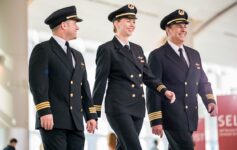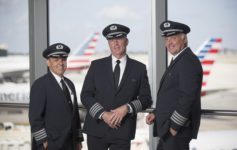
In Part 1, I debunked the myths around the 1500-hour rule. Here in Part 2, I examine why this rule still matters: what experience truly brings to safety, judgment, and operational resilience.
Why The 1500-Hour Rule Is Worth Defending
So, since there are no studies that show the 1500-hour rule has made aviation safer, why do I think it’s a good idea? I think as an airline passenger you have the right to expect the pilots in charge of your safety aren’t only qualified but, possess a requisite minimum of experience as well. The difference between 250 and 1500 hours in terms of aeronautical knowledge and experience is huge.
There is so much learning that goes on during that time and I don’t think the right place to learn is in the cockpit of an airliner with paying customers behind you. The right seat of an airliner is also a terrible place to develop flying skills. Automation dependency is a real problem in the industry and it’s much worse when the pilot doesn’t have a solid foundation of hand-flying skills to start with. While there may not be a study that correlates a 1500 hour minimum with an increase in safety, that’s not the same thing as saying there isn’t any evidence that argues for an increase in experience.
Lessons From Ethiopian 302
A prime example is found in Ethiopian 302 the Ethiopian 737 MAX crash. That first officer had only 361 hours of total time of which 207 were in the 737. Which means, at best, before he began flying a modern jet with a high degree of automation, he had accumulated 154 hours of experience.
One of the key factors in that accident was the fact the aircraft remained at takeoff thrust until impact, resulting in high airspeeds that eventually exceed the upper limit and was a significant contributing factor to the accident. The Captain, who was flying, was almost certainly overloaded by the combination of failures and the physical effort required to fly the jet as MCAS trimmed the nose down.
I’m personally convinced that an experienced First Officer would have noted the overspeed and reacted to it. He would have been a partner in that cockpit helping to manage what was happening. He would likely not have become overloaded as seems to have happened with this First Officer. Given that MCAS was a known issue by the time this crash happened, I believe an experienced First Officer would have recognized what was happening and been able to help the Captain work through the issue successfully.
But with only 361 hours, 207 of which were likely on flights where the autopilot was engaged the majority of the time and nothing went wrong, this First Officer lacked the requisite experience and airmanship. That’s not an indictment of either crew member, it’s just the challenge they faced that day was very predictably too much to handle.
It’s something I’ve seen personally once when flying as a regional Captain with a 600-hour former intern First Officer. He was smart as heck and knew his job well. But one day when we had to execute a last-minute unexpected go around it was almost as if his brain shut down. Suddenly, he went from being a model FO to a dead weight occupying a cockpit seat. In that case a little coaxing from me got him back in the game but had it been a serious emergency where my own mental capacity was being challenged, it might have ended differently.
CONCLUSION
1500 hours isn’t a magical number. But it does represent an established level of experience to earn the FAA’s highest license. It also represents enough flying for a pilot to have encountered a multitude of situations that build airmanship. It’s a mark that has been equaled or exceeded by the vast majority of airline pilots in this country before they got their first job and it’s a mark that can easily be achieved through flight instruction. It’s a standard that enhances safety and it’s one that, despite its tortured path into being, is worth supporting.
While other nations use different thresholds, the U.S. chose consistency. The 1500-hour standard forces pilots to gain a broader base of experience before flying passengers, adding a layer of resilience to the system. Do you think the 1500-hour rule provides a reasonable universal benchmark that airlines should not be allowed to bypass in the rush to staff cockpits?




Spot-on as usual. Thank you.
I am a lifelong private pilot, and have been flying little airplanes since I was just a young kid, way way back in the 1960s. Yes, really – I learned to fly when I was in junior high school, a long time ago. Of course, I couldn’t fly solo until age 16 and couldn’t get my license until 17. But I got very good at handling a small airplane before I ever got behind the wheel of a car (made me a much better, safer, more skilled driver). I still fly a small plane today, and currently have over 1500 hours – every single minute of which was hand-flown, with almost zero “automation” (though GPS sure has made navigation easier!).
After countless flights, this is still 100% true: I learn something new on every single flight. Every one, no matter how mundane and routine it may have been, or how hairy and challenging it may have been. That accumulation of knowledge is absolutely priceless, and serves one well going forward as knowledge and experience builds on and reinforces what you knew previously.
As with anything in life, the more you practice it, the better you get at it. It’s true for athletes, musicians, pilots, and everyone else.
I am not a flight instructor but have had many flight instructors throughout my flying years (regular periodic training is good). Teaching others gives you great insights, sharpens your own skills, and exposes you to an incredibly wide and valuable set of “what ifs” that you can’t get elsewhere.
Everything that 121 Pilot says here rings true. Well said, sir.
Very kind sir thank you.
My grandfather flew C-47s in WW2 and then post war was hired by TWA flying everything they had from DC-3’s to 747s. I interviewed him for a careers class when I was in Junior High and I’ve never forgotten one thing he said to me. “The day you stop learning is the day you stop flying.” I probably have more hours today than he did and it’s as true now as it was when said it to me.
I always find it funny when people talk about skills learned attaining 1,500 hours. Ignoring the fact that most pilots gain those hours as CFI, teaching other to fly, and being I control of the plane generously speaking 10% if the time. And that time being demonstrating a skill once to a person that does understand and is incapable if giving useful feedback or even simple critique. Any CFI that I have flown with has stories of demonstrating a skill and failing and then moving on to give the student as much value as possible and letting them try.
Additionally, it feels disingenuous to say observing someone else flying 75 knots, in the pattern, in a simple aircraft is the critical skill airline pilots need. Learning turbine, high altitude, high speed skills can only be learned in the right seat with skilled captains. There are NTSB reports of airline pilots using skills learned in GA, best glide, killing people. They needed greater speed to turn the turbines and restart the plane. 1,500 hours of flying GA, all that muscle memory has killed people. Plane and simple.
1,500 hours serves the pilot union best, without being able to hiring new pilots quickly give airline pilots all the power in contract negotiations. That is the real value in 1,500. Mo other nation needs it, or suffers from not having it.
Just sayin’. Also feel free to ask me about the 65 year forced retirement.
Do you feel there is a certain amount of training that should be specifically hand-flying?
How do you feel about simulators, up to full-motion cockpits like the majors use?
I absolutely feel pilots need a solid foundation of hand flying and that they need to continue to practice that skill even when they make it to an airline. Post AF 447 at least in the US a regular part of our training is raw data hand flown approaches and landings to make sure we retain those essential skills.
I’m a big fan of simulators in the airline world as they provide a much higher quality of training and can safely allow training maneuvers that would be very dangerous in the real airplane.
That being said I don’t think it’s a good idea to take a pilot with minimal hours in real aircraft and just wrack up a bunch of simulator hours. The simulator isn’t the real world and its best use is to train pilots on a new aircraft and train maneuvers (like engine failures) that would be dangerous if done in the airplane. It’s not a substitute for a solid foundation of real world flying experience.
Given that mental health is fast becoming the largest factor in relation to fatal airline accidents how do you think that compares to the issue of hours? Why are few talking about this in the industry when it appears far more a component over the past ten years?
I agree mental Health is an issue and it is something that people have been talking about. It’s also a problem that defies easy solution.
For example at least in the US all the airlines have very well developed programs to help pilot that may be struggling with alcohol. These programs provide fully paid services to help a pilot recover and return to flying and are well known. Yet we still see pilots being pulled off airplanes when they are unfit to fly.
I think a huge part of the problem is that any program to address these issues will rely on to a large extent the pilot recognizing that they need help and seeking it out.
And yet again, the Colgan crash that started the mythical 1500 rule where both 2000 hour pilots. Experience doesn’t come before basic competence.
Absolutely not. No question that the rule would not have changed the outcome at all.
That being said experience is a key component of competence.
This post doesn’t any sense, Boeing basically lied and hid facts about their new plane design basically said it flew the same, pilot dont need simulator trainining, even though they had to introduce a MCAS to combat moving the engines further back. And we’re blaming lack of pilot hours considering the incident happened twice within 9 months.
I do remember reading that even before MCAS added its extra smarts/complications, that older 737s had a memory procedure/rule that said if the automatic trim wasn’t working, turn it off and, set the trim, and fly the plane. And that the accident plane exhibited the same issue on a flight the day before and a different cockpit crew was having the same big trim problems. And that an off-duty pilot in the jump seat told them to disable the automatic trim via the two switches. That stopped MCAS from dialing in nose down trim. And those pilots decided to fly on to their destination (which seems like a surprising decision)
Apparently no note on the “two switches” was in the log and the next crew apparently wasn’t aware of that procedure.
I’m not at all excusing Boeing’s terrible, single point of failure design. MCAS added a new way to get runaway trim, But the runaway trim recovery procedure was apparently there for years.
I’m not a pilot. The above is what I recall from reading about the 737 Max crashes.
Europe doesn’t have the 1500 hour “rule” and seem to be doing just fine from a safety standpoint, why? 1500 hour rule was pushed by the pilot’s union to restrict the pilot pool. Has nothing to do with safety. Racking up hours flying a Piper Cub has zero correlation with flying a modern airliner, in fact it might introduce bad habits that have to be unlearned.
I think one of the problems with the experience required to safely operate an airliner is where does it come from now? 25 years ago there were lots of opportunities for young pilots to gain experience by flying for small cargo companies, flying cancelled bank checks, pipeline and powerline patrols. Now it seems like you get your CFII and MEI and fly the same training flights over and over until you hit 1500 hours.
The 1500 hour rule is BS. As a previous poster had said both colgan crash pilots (which started this 1500 hour rule) had over 2,000 flight hours. This new rule killed a lot of opportunities for young pilots and cut the pilot pool for the regional airlines. I don’t ever want to hear the airlines crying and whining about they don’t have enough pilots. You cannot tell me that somebody with 1500 hours in a 172 versus somebody with say 500 to 600 hours in bonanzas, multi-engine pistons, and helicopters has better experience. I had mentioned this to an Atlas Air pilot and former F-18 driver and he just reached out his hand and smiled. That should tell you something right there.
From what I remember, U.S. airlines weren’t hiring pilots even with 1500 hours until recently and now many new hires need more than 1500 because of oversupply in the post-COVID flight training boom. Before the 1500 hour rule, there were paths to get to 1500 hours for newly minted commercial pilots with 250 hours. Now the regional first officer route has been closed as an experience builder and many pilots are building time banding around the pattern as flight instructors if they can get a job as a flight instructor. Many flight schools are fully staffed with instructors trying to build time and some I have seen on Facebook posting resumes with over 1500 hours and can’t get hired anywhere because the flight school won’t bring on someone who won’t stay and airlines are hiring few pilots than the schools are churning out.
The first officer correctly identified the issue. The memory item for runaway trim is to disengage the electronic trim and not to accelerate. It’s a common memory item. The captain should’ve been well aware. Sometimes even with an inexperienced first officer, the problem is in the left seat. For instance, the recent Air India incident, Malaysia MH370. I personally had an incident where I warned the captain (fresh off OE) we would be high for an RNAV approach into Nassau. He shined me on, and we wound up going around. It doesn’t matter how experienced your first office area is if the captain is not inclined to work as a team. It appears as though the first officer in the Ethiopian flight was trained well, he just was not included in the decision-making. That’s a shame in a crew operated aircraft.
Yeah well as a 121 pilot for one of the big 4 my opinion is that we are the only country in the world doing that, safety data doesn’t support that at all, Flying 1500 hours in a c172 doing traffic patterns or the same ILS every day doesn’t improve your skills plus flying a jet has nothing to do with flying a Skyhawk or a seminole. It would be a lot better to force every pilot to have 100 hours in a jet full motion sim instead of the idiotic 1500 rule.
Lot of major airlines, especially in Europe, hired and trained pilots with 0 hours. “Ab initio programs”. They start flying tge airlines as second officers after completion of training with a commercial/instrument/multi engine license and about 300 hours of flying experience.